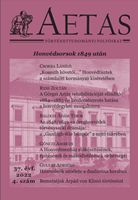A Honvédmenház előkészítésének, építésének és működtetésének nehézségei (1869–1882)
The Challenges of the Development, Construction, and Operation of the Veterans’ Home (1869–1882)
Author(s): Ambrus GöncziSubject(s): Military history, Sociology of Culture, 19th Century, Socio-Economic Research
Published by: AETAS Könyv- és Lapkiadó Egyesület
Keywords: Military History; Veterans; Veterans’ Home (1869–1882);
Summary/Abstract: There are few chains of events in Hungarian history that universally exemplify the ethos of homeland and progress, justice, patriotism and self-sacrifice. The Revolution of 1848-49 is without doubt one of these. As soon as the political circumstances allowed it for a short time in the Spring of 1861, former soldiers immediately created associations to support the injured or impoverished veterans of the revolution, either financially or otherwise. After 1867 the idea of a veterans’ home also surfaced, and in 1896 the national assembly of Hungarian soldiers (Országos Honvédgyűlés) made a decision to create such an institution in Pest. The formal opening of the Veteran’s Home took place three years later, on 29th September 1872, but the committee supervising the project formed by the Council of Veteran Associations (Honvédegyletek Központi Választmánya) and headed by János Vidats had to overcome several obstacles during the process. The first decade of the institution was also characterized by several challenges, and many times the committee and the leader at the time came under attack for the faults in the operation of the Veterans’ Home. According to the original plans the building was supposed to house 80 people, but by the end of the 1870s the capacity was only 60, while elderly veterans often were not provided sufficient care, and many residents even fled the home. Meanwhile the government held the veteran associations trying to preserve the institution’s independence under constant pressure, and at the same time sup ported those veteran organizations that would have accepted the government takeover of the Veterans’ Home. This did come to pass in 1882, leading to financial stability for the previously struggling institution, and from 1898 it could even increase its capacity. From 1901 150 former soldiers received care and accommodation at 114 Soroksári Road. The number of residents constantly decreased during the 1910s, and from the 1920s the institution also hosted the veterans and the injured of World War I. From 1941 the Veterans’ Home partially became a care center for the wounded soldiers of the new war, while a car repair shop also operated on the property. The building unfortunately did not survive World War II, and a memorial for this historically and culturally significant institution is still waiting to be made.
Journal: AETAS - Történettudományi folyóirat
- Issue Year: 2022
- Issue No: 4
- Page Range: 85-98
- Page Count: 14
- Language: Hungarian

